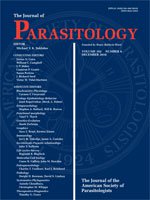Host specificity of parasites is a basic principle in parasitology; however, it is not easily measured. Previously, host specificity was calculated as the number of species that a parasite infected, but this is not an accurate description of host usage because some species are capable of being infected but do not contribute to the completion of the life cycle. Instead, measures of host specificity should take into consideration interactions between a parasite and a potential host species as well as interactions between current and subsequent hosts in the life cycle. The objectives of this study were to track the development of 2 trematode species, Halipegus eccentricus and Halipegus occidualis, in 3 phylogenetically and ecologically distinct microcrustacean second intermediate hosts, and then evaluate the extent to which each of these hosts contributed to transmission of each Halipegus species to the next odonate host in the life cycle. All 3 microcrustacean species exposed became infected with both species of Halipegus. The patterns of growth of H. eccentricus and H. occidualis were similar, but there were consistent differences in the rates of growth among the microcrustacean species in both Halipegus species. Regardless of host species infected, all individuals of both species were considered to be developmentally infective to the next host in the life cycle by 19 days postexposure (DPE) when they lost their excretory bladder. Worms of varying sizes were capable of surviving without this structure, suggesting that there is not a strong relationship between the rate of growth of the metacercariae and the development of their osmoregulatory system. Although Halipegus species were capable of living without an excretory bladder at 19 DPE, there were differences in their size and rates at which the 3 microcrustaceans contributed to transmission of the parasites to subsequent odonate hosts. Collectively, under controlled laboratory conditions, there was an approximate 2-fold difference in the average percentage of worms that established in odonates from the ostracod, Cypridopsis sp., than from the harpacticoid copepod, Phyllognathopus sp., and the difference was nearly 3-fold between Cypridopsis sp. and the cyclopoid copepod, Thermocyclops sp. Therefore, despite all 3 microcrustacean species becoming infected, not all species were equally suited for transmission and completion of the life cycle. Differences among the 3 microcrustacean species in cercaria ingestion, metacercarial growth and development, and odonate predation rates on infected microcrustacean species were important factors in determining transmission of the 2 Halipegus species to odonate hosts.
How to translate text using browser tools
1 December 2016
Evaluating the Biological and Ecological Factors Influencing Transmission of Larval Digenetic Trematodes: A Test of Second Intermediate Host Specificity of Two North American Halipegus Species
Heather A. Stigge,
Matthew G. Bolek
ACCESS THE FULL ARTICLE

Journal of Parasitology
Vol. 102 • No. 6
December 2016
Vol. 102 • No. 6
December 2016




